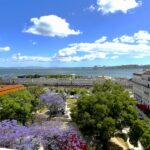Planning a trip to Peru? Preparation is the key before setting foot on Peruvian soil. I did a lot of research about weather, transportation, accommodation options, altitude sickness prevention, and currency exchange tips in Lima, Cusco, and Machu Picchu to ensure a smooth journey. Here’s what you need to know before getting on your Peruvian adventure!
☀️ Weather
Cusco & Machu Picchu: The region has two distinct seasons. The dry season (May-October) offers perfect hiking weather but comes with larger crowds. The rainy season (November-April) brings daily afternoon showers but fewer tourists and lower prices.
Lima: The capital experiences sunny, humid summers (December-April) with temperatures exceeding 30°C, while winters (May-November) are cloudy and cool. I visited in late March-early April and encountered perfect conditions – while it rained daily in Cusco (mainly noon/evening), it didn’t impact sightseeing. Lima was consistently sunny and hot.
If you plan to visit both Lima and Cusco in one trip around the similar time as mine, make sure to pack both summer and light winter clothes.
🛏️ Accommodation
Hotels are surprisingly affordable in Peru. A 4-star hotel costs around CA$80-90 per night, but book early for the best rates. Here are my tried-and-tested recommendations:
Cusco: Illas Inn
- Boutique hotel near PeruRail station
- Excellent location (2-minute walk to station)
- Friendly staff offered great local tips
Lima: Wyndham Hotel Costa Del Sol Lima City
- Safe, central location
- Rooftop pool bar with city views
- Clean, well-maintained facilities
🚗 Transportation
Uber is the most reliable and affordable option in both Lima and Cusco. For Machu Picchu visits, book PeruRail tickets well in advance – I recommend the Expedition service for better value. Between cities, domestic flights are your best option.
Travel Tip: Always keep printed copies of your transportation tickets, especially for PeruRail.
💵 Currency Exchange
If you’re traveling to Peru from a country where the Sol (PEN) isn’t readily available for exchange, like Canada, it’s wise to bring along some US dollars (USD) as a backup – USD is widely accepted in Peru, especially in major cities like Lima and Cusco.
- Exchange at the Airport: Upon arrival, you can exchange a portion of your USD at the airport for immediate use.
- Local Currency Exchange Shops: Throughout Peru, especially in popular tourist areas like Cusco and Lima, you’ll find many private-run currency exchange shops. These shops often offer competitive rates, and you can sometimes negotiate for a better deal. So don’t be shy to bargain with the staff there, especially if you’re exchanging larger amounts.
📱 Network
SIM Card – DO NOT buy it at the Lima Airport – the price is ridiculously high. If you need a SIM card immediately, check out the Claro shop at national departures (2nd floor of the airport) and you may be able to get a better deal.
If you are not in a hurry, you can get much better deals in the Lima city area. Check out this article for more SIM card options.
🎒 What to Pack
📄 Documents
- Passport or any applicable travel documents
- Printed Tickets – required if you are taking PeruRail to Machu Picchu
- Currency Exchange
📱 Electronics
- Laptop, AirPods, AirTag
- Chargers – Laptop, iPhone
- Charger Converter – in Peru, the power plug sockets are type A and C. The standard voltage is 220 V and the frequency is 60 Hz
👕 Clothing
- Lightweight jacket for Cusco
- T-shirts and summer tops for Lima
- Long pants
- Shorts
- Sneakers
- Sunglasses
🌂 Others
- Umbrella / Poncho
- Masks
- Sunscreen
- Medication – ibuprofen, acetazolamide, or dexamethasone for high altitudes
- Bug repellent for Machu Picchu
🏔️ Altitude Sickness
If you travel to higher than 8,000 feet above sea level without letting your body adjust to the new altitude, you may experience altitude sickness due to the low oxygen levels in the air. Symptoms include headache and nausea. Here are some tips from CDC and Cleveland Clinic to avoid altitude sickness:
- Ascend gradually. Avoid travelling from a low elevation to an elevation higher than 9,000 feet (2,750 m) above sea level in one day.
- Rest and adjust. Spend a few days at 8,000–9,000 feet before travelling to a higher elevation. This gives your body time to adjust to the lower oxygen levels. Alternatively, consider taking day trips to a higher elevation and then returning to a lower elevation to sleep.
- Avoid alcohol. Don’t drink alcohol or do heavy exercise for at least the first 48 hours after you arrive at an elevation above 8,000 feet.
- Stay hydrated. Drink 3-4 quarts of water per day.
- Don’t eat too much but make sure your carbs intake: Eat a diet that’s more than 70% carbohydrates.
📚 Related Posts
- 🇵🇪 Lima Travel Guide 2024: Complete 3-Day Itinerary
- 🇵🇪 Cusco Travel Guide 2024: The Ultimate 4-5 Day Itinerary
- 🇵🇪 How to Visit Machu Picchu in One Day from Cusco: My Complete Guide
- 🇵🇪 Taste of Peru: Must-Try Local Peruvian Food🍽️
- 🇵🇪 Peru Travel Guide 2024: Things to Know Before You Go
- 🇵🇪 9 Days Solo Travel in Peru: Lima, Cusco & Machu Picchu (Part 2)
- 🇵🇪 9 Days Solo Travel in Peru: Lima, Cusco & Machu Picchu (Part 1)

📍 Plan Your Peru Adventure!
I’ve created a detailed Notion travel planner template to help make your Peru trip planning a breeze! Inside you’ll find:
✈️ Complete travel tips
📝 Customizable packing lists
🍽️ Local food recommendations
💰 Budget tracker
🗺️ Interactive Google Maps with all locations
Get Your Planner Here: ⛰️ Peru Cusco & Lima 9-Day Travel Itinerary Planner




